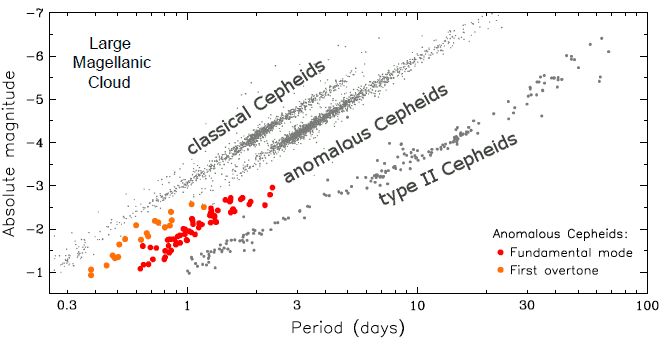Anomalous Cepheids
Anomalous Cepheids (sometimes called BL Bootis stars) are relatively massive (1-2 solar masses), metal-deficient pulsating stars, which spread between classical and type II Cepheids in the period-luminosity diagram. There are two leading hypotheses for the origin of anomalous Cepheids: that they are intermediate-age stars with exceptionally low metallicity, or that they are coalesced old binary stars. Until recently, most of the known anomalous Cepheids were found in nearby dwarf galaxies and only a few such stars were identified in Galactic globular clusters. This situation changed due to the OGLE project. First, we discovered as many as 268 anomalous Cepheids in the Magellanic Clouds (Soszyński et al. 2008, 2015), then we identified 119 anomalous Cepheids in the Milky Way (Soszyński et al. 2017, 2020, Udalski et al. 2018). These are the largest samples of such objects ever detected in any stellar environment. Below we present the period-luminosity diagram for Cepheids in the Large Magellanic Cloud. Red and orange points show the position of anomalous Cepheids pulsating in the fundamental mode and first overtone, respectively.
 |
Period-luminosity relations of classical (grey points), type II (larger grey points) and anomalous Cepheids (red and orange points) in the Large Magellanic Cloud. As the "luminosity" we used the reddening-free Wesenheit index, defined as WI = I - 1.55(V - I) - DM, where I and V are mean luminosities of Cepheids in these passbands, and DM = 18.5 mag is the distance modulus of the Large Magellanic Cloud. |
Fundamental-mode pulsators
Anomalous Cepheids pulsating in the fundamental mode have periods from a few hours to over 2 days. They have asymmetric light curves with a rapid rise to maximum and a slow decline. Many of the fundamental-mode pulsators exhibit a small bump just before the rise to maximum light. The light curves of anomalous Cepheids are very similar to the light curves of classical Cepheids (for periods above 1 day) and RR Lyrae stars (below 1 day), and the distinction between these types of pulsating stars is difficult, but possible thanks to the light curve analysis using Fourier decomposition technique. Below we present OGLE I-band light curves of six anomalous Cepheids from the Large Magellanic Cloud and Milky Way. Move the mouse pointer over the image to see the designation and J2000 equatorial coordinates of a given star.
First-overtone pulsators
First-overtone anomalous Cepheids have periods from about 0.3 days to slightly over 1 day. Generally, they have smoother light curves than the fundamental-mode pulsators, with rounded maxima and minima, although some stars exhibit a somewhat sharper maximum.
A triple-mode anomalous Cepheid
Currently, there is only one known anomalous Cepheid pulsating in more than one radial mode. OGLE-GAL-ACEP-091, discovered in the OGLE photometric database (Soszyński et al. 2020), is a triple-mode pulsating star with the fundamental, first-overtone, and second-overtone modes simultaneously excited. The disentangled light curves associated with these three modes are shown in the figure below.
|
